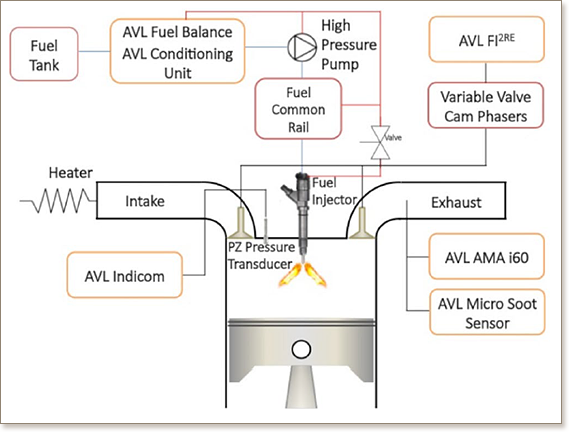Low load limit extension for gasoline compression ignition using negative valve overlap strategy
R. Vallinayagam, A. AlRamadan, S. Vedharaj, Y. An, J. Sim, J. Chang, B. Johansson
SAE Technical Paper Series, 2018-01-0896 (2018)

Gasoline compression ignition (GCI) is widely studied for the benefits of simultaneous reduction in nitrogen oxide (NO) and soot emissions without compromising the engine efficiency. Despite this advantage, the operational range for GCI is not widely expanded, as the auto-ignition of fuel at low load condition is difficult. The present study aims to extend the low load operational limit for GCI using negative valve overlap (NVO) strategy. The engine used for the current experimentation is a single cylinder diesel engine that runs at an idle speed of 800 rpm with a compression ratio of 17.3. The engine is operated at homogeneous charge compression ignition (HCCI) and partially premixed combustion (PPC) combustion modes with the corresponding start of injection (SOI) at 180 CAD (aTDC) and 30 CAD (aTDC), respectively. In the presented work, intake air temperature is used as control parameter to maintain combustion stability at idle and low load condition, while the intake air pressure is maintained at 1 bar (ambient). The engine is equipped with variable valve cam phasers that can phase both inlet and exhaust valves from the original timing. For the maximum cam phasing range (56 CAD) at a valve lift of 0.3 mm, the maximum allowable positive valve overlap was 20 CAD. In the present study, the exhaust cam is phased to 26 CAD and 6 CAD and the corresponding NVO is noted to be 10 CAD and 30 CAD, respectively. With exhaust cam phasing adjustment, the exhaust valve is closed early to retain hot residual gases inside the cylinder. As such, the in-cylinder temperature is increased and a reduction in the required intake air temperature to control combustion phasing is possible. For a constant combustion phasing of 3 CAD (aTDC), a minimum load of indicated mean effective pressure (IMEP) = 1 bar is attained for gasoline (RON = 91) at HCCI and PPC modes. The coefficient of variance was observed to below 5% at these idle and low load conditions. At the minimum load point, the intake air temperature required dropped by 20°C and 15°C for NVO = 30 CAD at HCCI and PPC modes, respectively, when compared to NVO = 20 CAD and NVO = 10 CAD. Similarly, for the load range of IMEP = 1 to 3 bar, decrease in temperature requirement is noted for negative valve overlap cases and the translational table in terms of d (Tin)/d (NVO) is attained. However, the low load limit was extended with negative valve overlap at the expense of decreased net indicated thermal efficiency due to heat losses and reduction in gas exchange efficiency. Ultra low soot concentration and NO emission were noted at HCCI condition.